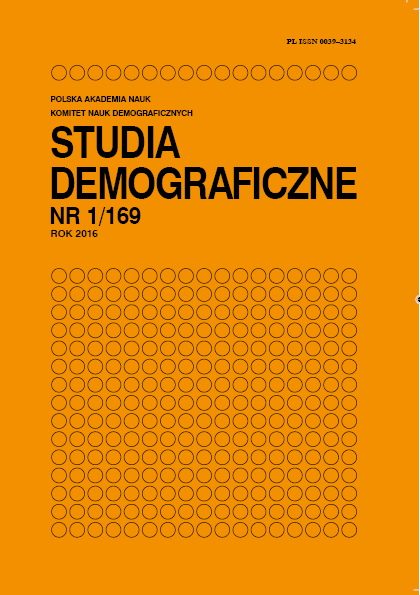Polki w Norwegii – decyzje i plany prokreacyjne
Main Article Content
Abstract
Given the scale and pace of post-EU accession migrations from Poland, as well as age and gender structure of their participants, an increased interest in family behaviour and intentions of this group has been recently noted. The observed interrelations between migration and family building processes are multidimensional. Thus, this study aims to investigate interrelations between migration, childbearing decisions and intentions of Polish female migrants in Norway. The paper is based on a survey research conducted among Polish female migrants in 2014–2015. The results show that majority of immigrants was childless upon arrival. For those, who had a child before migration, the mobility occurred in a relatively early stage of family formation process. However, a concentration of births shortly after migration can be observed. This concerns mostly women migrating to join their husbands or partners. An opposite evidence is observed regarding respondents who had one child upon arrival to Norway – only few of them proceeded to the second birth. Almost 58% of respondents wants to give birth to their next child in Norway. More importantly, majority of women planning a long-term stay in Norway still has positive or uncertain childbearing intentions.
Article Details
References
[2] Adserà A., Ferrer A.M., 2013, The fertility of recent immigrants to Canada, Discussion Paper Series, Forschungsinstitut zur Zukunft der Arbeit, nr 7289.
[3] Andersson G., 2004, Childbearing after migration: fertility patterns of foreign-born women in Sweden, „International Migration Review”, vol. 38, nr 2, 747–774.
[4] Andersson G., Scott K., 2007, Childbearing dynamics of couples in a universalistic welfare state: The role of labor-market status, country of origin, and gender, „Demographic Research”, vol. 17, nr 30, 897–938.
[5] Babbie E., 2013, Podstawy badań społecznych, Wydawnictwo Naukowe PWN, Warszawa.
[6] Blau F.D., 1992, The fertility of immigrant women: Evidence from high-fertility source countries, Working Paper no. 3608, National Bureau of Economic Research, Massachusetts.
[7] Carlson E.D., 1985, The impact of international migration upon timing of marriage and childbearing, „Demography”, vol. 22, nr 1, 61–72.
[8] Creswell J.W., 2013, Projektowanie badań naukowych. Metody jakościowe, ilościowe i mieszane, Wydawnictwo Naukowe Uniwersytetu Jagiellońskiego, Kraków.
[9] Cygan-Rehm K., 2013, Do immigrants follow their home country’s fertility norms?, IWQW Discussion Paper Series, nr 04/2013.
[10] Ford K., 1990, Duration of residence in the United States and the fertility of U.S. Immigrants, „International Migration Review”, vol. 24, nr 1, 34–68.
[11] Friberg J., 2013, The Polish worker in Norway. Emerging patterns of migration, employment and incorporation after EU’s eastern enlargement, PhD Dissertation, Fafo-report, 2013:06.
[12] Goldstein S., 1973, Interrelation between migration and fertility in Thailand, „Demography”, vol. 10, nr 2, 225–241.
[13] Goldstein S., Goldstein A., 1981, The impact of migration on fertility – an own children analysis for Thailand, „Population Studies – a Journal of Demography”, vol. 35, nr 2, 265–284.
[14] GUS, 2014, Informacja o rozmiarach i kierunkach czasowej emigracji z Polski w latach 2004–2013, Departament Badań Demograficznych i Rynku Pracy, Warszawa.
[15] Janta B., 2013, Polish migrants’ reproductive behaviour in the United Kingdom, „Studia migracyjne – Przegląd Polonijny”, nr 3, 63–96.
[16] Kahn J.R., 1988, Immigrant selectivity and fertility adaptation in the United States, „Social Forces”, vol. 67, nr 1, 108–128.
[17] Kahn J.R., 1994, Immigrant and native fertility during the 1980s: Adaptation and expectations for the future, „International Migration Review”, vol. 28, nr 3, 501–519.
[18] Kotowska I. (red.), 2014, Niska dzietność w Polsce w kontekście percepcji Polaków. Diagnoza Społeczna 2013, Ministerstwo Pracy i Polityki Społecznej, Centrum Rozwoju Zasobów Ludzkich, Warszawa.
[19] Kulu H., 2005, Migration and fertility: Competing hypotheses re-examined, „European Journal of Population”, vol. 21, 51–87.
[20] Lübke Ch., 2015, How Migration Affects the Timing of Childbearing: The Transition to a First Birth Among Polish Women in Britain, „European Journal of Population”, vol. 31, 1–20.
[21] Marczak J., 2013, Childbearing intentions of Polish nationals in Poland and in the UK: Progression to the second child, PhD Thesis.
[22] Milewski N., 2007, First child of immigrant workers and their descendants in West Germany: Interrelation of events, disruption, or adaptation?, „Demographic Research”, vol. 17, nr 29, 859–896.
[23] Milewski N., 2010, Fertility of immigrants. A two-generational approach in Germany, Berlin, Springer.
[24] Mulder C.H., Wagner M., 1993, Migration and marriage in the life course: A method for studying synchronized events, „European Journal of Population”, vol. 9, 55–76.
[25] Ng E., Nault F., 1997, Fertility among recent immigrant women to Canada, 1991: an examination of the disruption hypothesis, „International Migration Review”, vol. 35, nr 4, 559–580.
[26] Persson L., Hoem J.M., 2014, Immigrant fertility in Sweden, 2000–2011: A descriptive note, „Demographic Research”, vol. 30, nr 30, 887–898.
[27] Robards J., Berrington A., 2015, The fertility of recent migrants to England and Wales: interrelationship between migration and birth timing, ESRC CPC Working Paper, 65.
[28] Schmid S., Kohls M., 2009, Reproductive behaviour of migrant women in Germany: Data, patterns and determinants, „Vienna Yearbook of Population Research”, 39–61.
[29] Statistisk Sentralbyrå, 2015, Statistikkbanken, www.ssb.no (data dostępu: 15.11.2015).
[30] Steinkellner A., 2015, Befolkningens utdanningsnivå og arbeidsmarkedsstatus, Rapporter, 2015/11, Statistisk Sentralbyrå, Oslo-Kongsvinger.
[31] Stephen E.H., Bean F.D., 1992, Assimilation, disruption and the fertility of Mexican origin women in the United States, „International Migration Review”, vol. 26, nr 1, 67–88.
[32] Testa M.R., 2012, Family sizes in Europe: Evidence from the 2011Eurobarometer Survey, European Demographic Research Papers.
[33] Toulemon L., 2004, Fertility among immigrant women: new data, a new approach, „Population and Societies”, vol. 400, 1–4.
[34] Waller L., Berrington A., Raymer J., 2012, Understanding recent migrant fertility in United Kingdom, Centre for Population Change Working Paper, nr 27.
[35] White M.J., Moreno L., Guo S., 1995, The interrelation of fertility and geographic mobility in Peru: a hazards model analysis, „International Migration Review”, vol. 29, nr 2, 492–514.
[36] Zumpe J., Dormon O., Jefferies J., 2012, Childbearing among UK born and non-UK born women living in the UK, Office for National Statistics.
